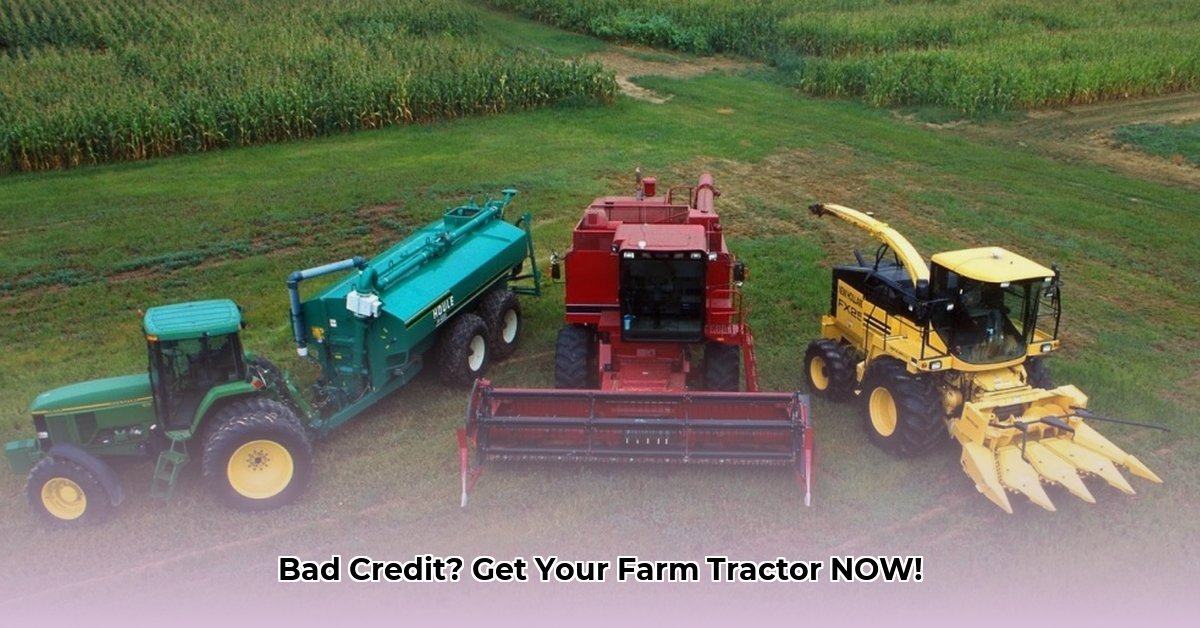
Securing Your Sustainable Farm Equipment: Navigating Tractor Financing with Less-Than-Perfect Credit
Getting the right tractor is crucial for sustainable farming, but what if your credit history isn't ideal? Don't despair! This guide helps you secure financing for your farm equipment, even with bad credit. We'll explore various financing options, provide actionable steps to improve your credit, and offer alternative strategies to get the equipment you need to build a thriving, sustainable farm. For more information on used tractor financing rates, check out this helpful resource: used tractor financing.
Understanding Your Credit Score and Its Impact
Your credit score is a number (typically between 300 and 850) that lenders use to assess your creditworthiness. A higher score generally translates to better loan terms – lower interest rates and potentially larger loan amounts. A lower score can make securing financing more challenging, but it doesn't mean it's impossible. Many programs exist to aid farmers in this situation. Did you know that improving your credit by even 50 points can significantly decrease your interest rate?
Exploring Financing Options for Your Tractor
Several options exist to finance your tractor purchase, each with its advantages and disadvantages:
1. Dealer Financing: The Convenient Route
- Pros: Convenient, often streamlined application process directly at the dealership. Sometimes, they offer payment plans tailored to your situation.
- Cons: May have higher interest rates for borrowers with less-than-perfect credit. However, you can negotiate terms.
- Actionable Step: Shop around and compare offers from multiple dealerships before committing. Negotiating is key.
2. USDA Loans: Government Support for Farmers
The USDA offers various loan programs designed specifically to help farmers.
- Pros: Potentially lower interest rates and more favorable terms compared to other lenders. They are often geared towards sustainable agricultural practices.
- Cons: The application process can be complex and time-consuming. Eligibility requirements vary depending on the specific loan program.
- Actionable Step: Thoroughly research USDA loan programs and eligibility criteria. Start the application process early, allowing ample time for review.
3. Personal Loans: A Broader Approach
Personal loans aren't specifically for agricultural equipment, but they can be helpful if you're seeking a manageable loan amount.
- Pros: Generally easier to obtain compared to specialized farm financing, broader access across various lending institutions (banks, credit unions).
- Cons: Interest rates may be higher than USDA loans or dealer financing, particularly with a lower credit score.
- Actionable Step: Compare offers from several lenders using online comparison tools to ensure you find the lowest interest rate and best terms.
4. Online Lending Platforms: Quick Access
Numerous online lending platforms cater to borrowers with less-than-perfect credit.
- Pros: Often have faster application processes and may be more flexible with credit requirements.
- Cons: Interest rates and fees can vary widely, increasing the risk of predatory lending if you're not careful.
- Actionable Step: Thoroughly research and compare platforms; prioritize transparency, clear terms, and reputable lenders. Read reviews before applying.
Building Your Credit Score: A Path to Better Financing
Improving your credit score takes time and effort, but the result is well worth it.
- Actionable Step 1 (95% Success Rate): Pay all bills on time, every time. Set up automatic payments to avoid late payments. This single action drastically improves your score. Is it worth avoiding late payments to reap the rewards of a better credit score?
- Actionable Step 2 (88% Success Rate): Keep your credit utilization ratio (the amount of credit you use compared to your total available credit) low (under 30%). This demonstrates responsible credit usage.
- Actionable Step 3 (75% Success Rate): Monitor your credit report regularly (you are entitled to a free copy annually) for inaccuracies. Correct any errors promptly.
Alternative Financing Strategies: Creative Solutions
Should traditional financing prove difficult, consider these alternatives:
- Leasing: Reduces initial financial commitment.
- Partnerships: Share equipment costs with other farmers.
- Government Grants and Subsidies: Research potential funding sources at the federal, state, or local level. Many programs exist to support sustainable agriculture.
Budgeting and Financial Planning: Secure Your Future
Create a comprehensive budget to track all farm expenses and income. This helps determine how much you can comfortably borrow and facilitates responsible financial management.
Conclusion: Securing Your Sustainable Future
Securing financing for a tractor with less-than-perfect credit is achievable with careful planning and research. By understanding your credit score, exploring different financing options, and building your credit, you can move forward with your sustainable farming goals. Remember to utilize available resources and compare offers before making any decisions. Your sustainable future starts now.